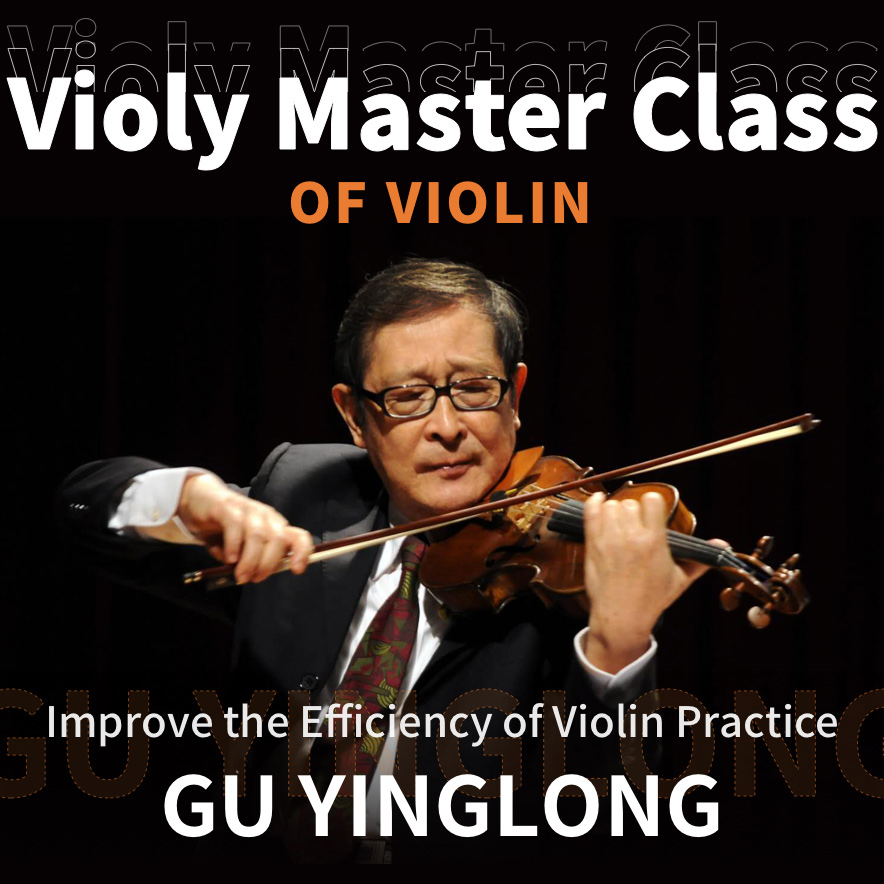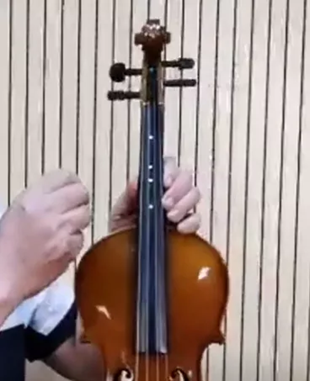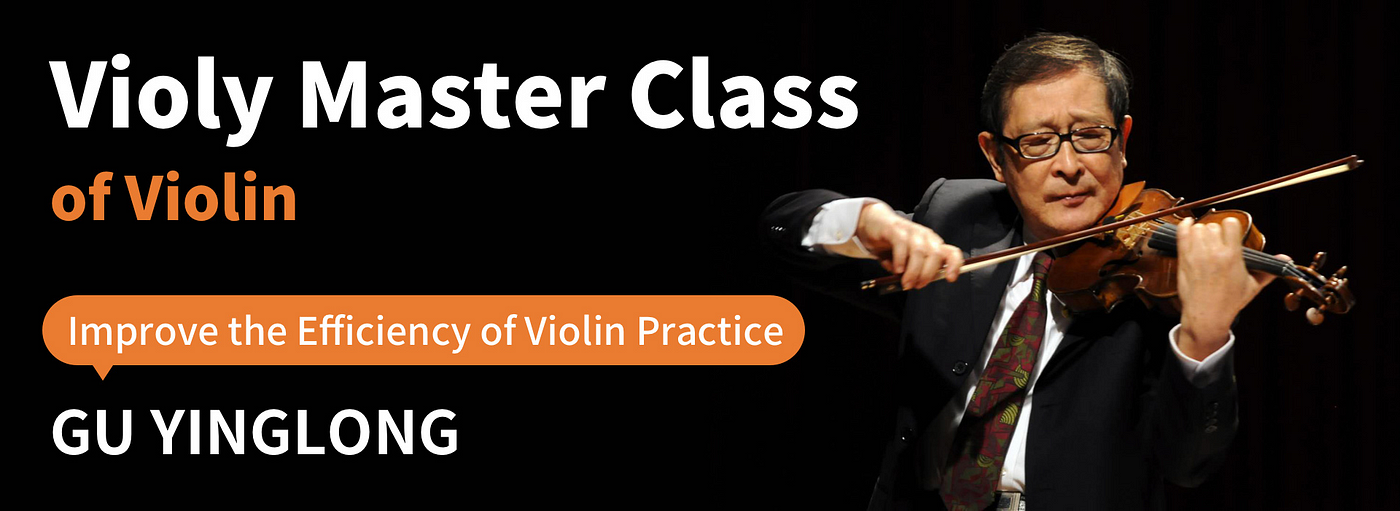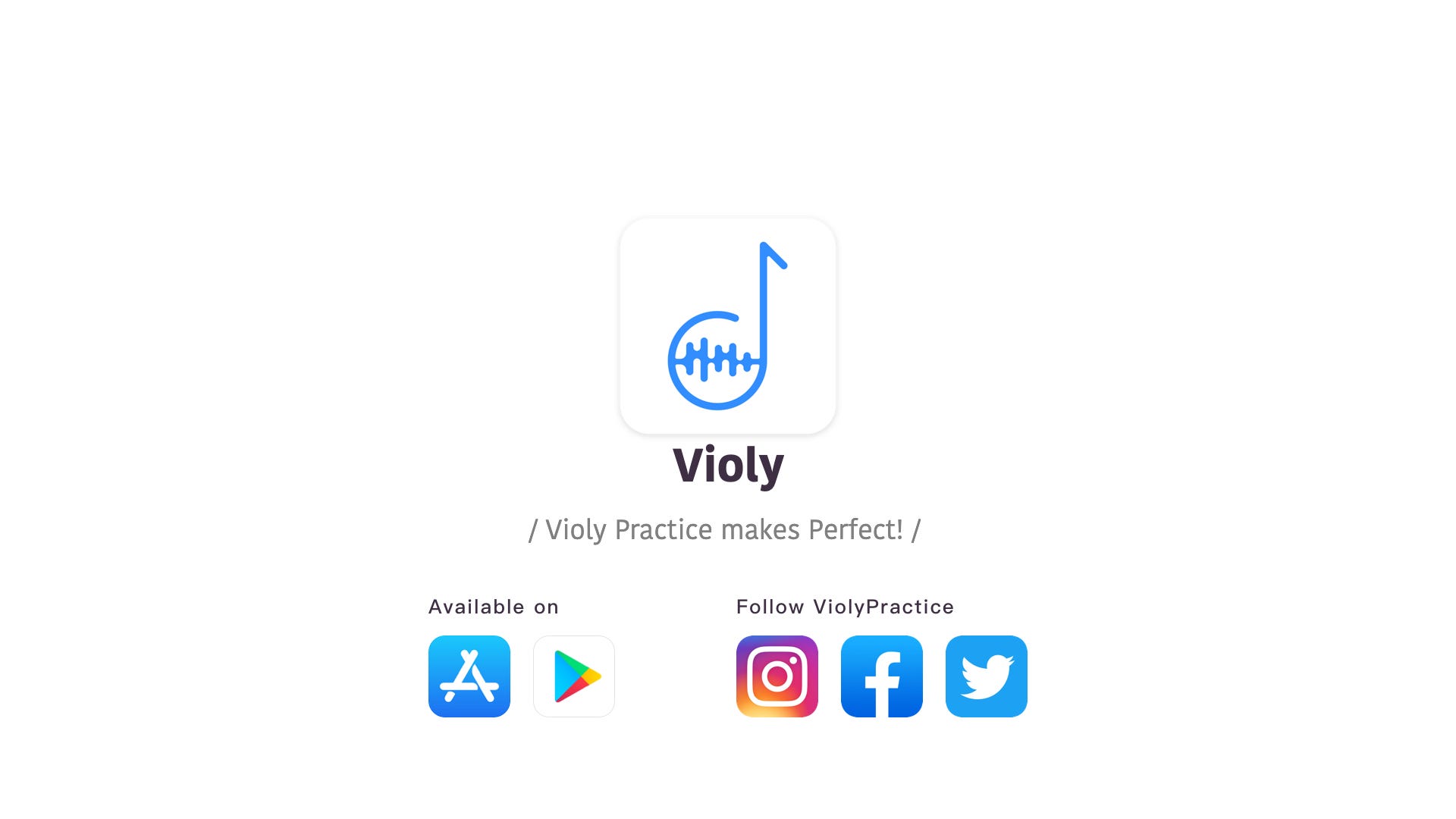Improve the Efficiency of Violin Practice
Gu Yinglong is a famous violin educator. In this Violy master class, he shared some tips about how to practice violin correctly and efficiently.

Content of Gu Yinglong’s lecture is as follows (edited in first person):
Young learners, teachers and parents, good evening! I am very glad to be here and talk about the art of violin. Tonigh, my topic is “how to improve the efficiency of violin practice”. I think the key points are normative hand positions, accuracy and methods. Let’s start from the hand positions.
Improve Your Intonation by Correcting the Left Hand Position
When it comes to the left hand position, students are most likely to have wrong thumb positions when holding the violin. Some students hold the neck tightly, and their thumb is stretched. Actually, there is space between your left thumb and index finger when you are holding the neck. The contact position of your thumb on the fingerboard should be slightly tilted, so your thumb is naturally placed on the neck.
Besides, wrong position of left little finger is another problem which is most likely to arise among students. It is not a good habit to hook up your little finger or put it beneath the fingerboard while playing. Our little finger should be relaxed and placed above the fingerboard. Like Professor Lin Yaoji said, the four fingers should be in a line. Our left hand should open up and all the fingers should be placed above the fingerboard getting prepared to play, like an open umbrella.
Actually, we need to press the strings with our finger tips. If we press a little harder, we can see the marks on our finger tips. Therefore, our index finger should tilt a little bit, with the first knuckle being placed on the neck. All fingers on our left hand should keep in the motion of knocking instead of being placed vertically on the fingerboard.
Only in this way can we improve our intonation comfortably and conveniently with normative hand positions.
Why Do We Have Poor Intonation?
In my opinion, it is because some students do not pay attention to their playing and some teachers ignore the fact as well.
I would like to give an example here:
Once I met a student who played skillfully. He marked the fingering with a pencil on the sheet music.
So I asked him: “Your intonation is not good. How long have you been learning the violin?”
He said: “I’ve been learning for three years.”
I answered: “Then you should have good intonation, but why are you still struggling with it? What are you looking at during playing? The fingering or the sheet music?”
He said: “The fingering.”
Did this happen to other teachers? If you see a student whose sheet music is filled with pencil marks of fingering, you are supposed to erase those marks for him or her.
Here are other interesting examples:
Many students apply wide tapes on the fingerboard to mark positions. I met quite a few students who play skillfully but have poor intonation. It turned out that most of them look at the tapes while playing.
The tapes are supposed to be used by violin beginners in the first three months. Later, students should be able to listen to their playing instead of relying on the tapes. Students need to master two things in advance: the correct finger position and the right feeling of pitch.
I suggest learners not apply tapes but use correction pen to dot the positions (as shown below), and after three months, these dots should only be seen by the students’ parents. If learners get used to the marks, they will not listen to their playing carefully, and their intonation will never be improved.

It is even more strange that some students play well but cannot tell at once what the pitch is when I point at a note on the sheet music. They need to read the whole piece again, and only then can they tell me the pitch. These students have learned the violin for years and play skillfully, but they are not able to read music well. They memorize the sheet music without understanding what they play, just like some people memorize what they read mechanically but do not know the meaning of the words.
Therefore, teachers need to notice the fact that some students never think during playing. They are supposed to help the learners avoid that.
What’s more, some students try to find the right finger positions one by one when playing the violin. It is not right. All our fingers should get prepared before pressing the strings. Then, we need to pay attention to the “independence” of fingers during the process of practicing slowly.
What Is the “Independence” of Fingers?
The “independence” of fingers means the fingers should be isolated from one another. My daughter Gu Wenlei went to Beijing to learn from Professor Lin Yaoji at the age of eight. Professor Lin asked her to practice Kreutzer’s Etude №9 slowly for six months, which was to help her understand the “independence” of fingers and grasp the skill.
I would like to emphasize that our fingers should not move randomly. The “independence” of fingers is very important in the art of violin. No matter which etude we are working on, we are supposed to avoid moving fingers randomly. All our fingers should get prepared and be “independent”. Meanwhile, no matter which finger position we are playing on, the first finger should always stay there, which is also important.
Besides, intonation is a “one-off deal”, which means once you start playing, it is already decided. Therefore, we need to think while playing.
Some learners tend to play fast in daily practice. As a result, they neglect the intonation. I would like to tell all students that practicing slowly is a “secret weapon”. Only practicing slowly can help you make progress. Also, we need to pay attention to our intonation, which means we should find the right pitch using eyes, mind and fingers, and then we should keep the whole system in the mind. Professor Lin said: Practicing the violin is like training the mind.
What Is the Best Practicing Method and What Is the Worst?
In my opinion, the worst practicing method is playing a piece to the end time after time; while the best method is to select the difficult parts of the sheet music, practice them slowly and constantly check the intonation by playing the open strings.

The Basic Skills of the Right Hand
Now let’s talk about the right hand. Students are also most likely to have wrong positions of right thumb and little finger. When they hold the bow, their right thumb tends to be stretched and tense. It is wrong. Our right thumb should touch both the frog and the stick. As for the little finger, students especially beginners should make sure that their right little finger is placed on the stick naturally instead of being straightened. Also, the index finger should be put on the stick gently.
I would like to give some advice to all learners. When you are playing the violin, the back of your right hand should keep flat, your palm should move outwards, and your forearm should be leading the move. Regardless of bow changing, string shifting or position changing, we should always keep in mind that the small movements are driven by the bigger ones.
During practicing, there are three things we need to pay attention to:
When we are shifting the strings, we should do it gradually instead of changing suddenly. Other people who listen to your playing should not notice the changing.
When we are changing the positions, we should do it gently and slowly. Other people are not supposed to notice what you are doing.
When we are changing the bow, we should do it naturally instead of making squeaky sounds.
Apart from what I mentioned above, we should also pay attention to the strength. First, we need to hold the bow with right strength. Second, we should put the violin on the shoulder gently. Third, left hand fingers should be placed on the fingerboard softly, and the left thumb should be put on the neck naturally.
Also, the movements of our right hand should be “flat, steady and straight”.
Like Professor Lin said, the movements of the right hand should be “flat, steady and straight”. “flat” refers to the four planes of four strings, and the three planes of two strings and the bow hair when we play double stops. The sound we produce on the violin can be beautiful if our right hand is relaxed while playing.
When we are shifting the strings and changing the bow, we should know that the small movements are driven by bigger ones. The etudes we play are written for practice of different techniques, such as détaché, staccato and string shifting. Now I take Kreutzer’s Etude №13 for an example and demonstrate the movements of string shifting. When we are about to shift the strings, we move our upper arm first, then we move the forearm. The movements are continuous. We should practice slowly and relax our shoulder and the whole arm, imagining that a drop of water flows from the shoulder to the fingers.
The Practice of Détaché
How can we practice détaché well? We need to “hang” the bow on the strings and put on the weight of the right arm and the bow. There are two things we need to do when playing détaché: “hanging” and “dragging”. “dragging” means that we are supposed to use the whole bow instead of a few parts.
Technically, we play with our forearm when using the upper half of the bow; when we use the lower half, we play with our upper arm. We should pay attention to the movements of our wrist when playing in the middle of the bow. The wrist should not be stiff. During playing, we should keep the seven planes I mentioned above in mind.
The Coordination of Our Left Hand and Right Hand
All fingers on our left hand should get prepared in advance so that we can find the right pitches at once. During my playing, I adjust the movements of my whole left hand in time without moving my fingers randomly. Why do I do this way? Because when we are shifting the strings, our fingers may be placed vertically on the fingerboard. Adjusting the movements of the whole hand can help us avoid wrong finger positions.
Besides, when it comes to bowing, we should follow Professor Lin’s advice: flat, steady and straight. “flat” refers to the planes I mentioned above. “steady” means the sound we produce should be steady. “straight” means the bow should be kept straight while playing. In other words, the bow should not be slanted or flipped.
During playing, the bow should be placed on the strings stably. When we are playing chords, our shoulder needs to be relaxed and the bow should have a “soft landing” on the strings.
In a word, being relaxed and thinking while playing are the most important things we need to keep in mind.
Staccato
Explosiveness is crucial to the playing of staccato. Explosiveness consists of 90% relief and 10% tension. My friend, Professor Liu Dahan from Xinghai Conservatory of Music, told me that the playing of staccato requires three movements: pressing, playing and releasing. Professor Liu’s words do make sense. When we are playing staccato, we press the strings and use the bow, then we need to let the bow glide as soon as the sound is produced.
Trill
How can we play trill fast? There is only one way: keeping the finger pressed on the string relaxed.
Q & A Session
Violy team: Many students find that their movements are unnatural or stiff while playing vibrato. How can we practice vibrato?
Gu Yinglong: Vibrato is an important violin technique. Currently, many students including those from music conservatories have trouble dealing with the skill. Last year, I attended the annual conference of Guangdong Violin Education Society and discussed the styles of vibrato with other teachers. Which style should we choose, finger vibrato, arm vibrato or wrist vibrato? Here I would like to make it clear that ways of vibrato playing are changing. We need to combine all three styles.
Professor Lin Yaoji said: the breeze stirs the leaves, the wind moves the branches, the gale sways the trunk. The styles of vibrato change according to the dynamics in sheet music. Our fingers should move in a “parallel” way instead of applying strength to the fingerboard.
The godmother of violin, Professor DeLay from Julliard School asked her students to set the metronome at 60 BPM and practice vibrato on the fourth position by moving the finger up and down. I have my own method, which is taught by my violin teacher Tang Long. This method fits every violin player.
Here are the movements:
First, put the violin on the shoulder without placing your chin on the chin rest.
Then, move your first finger from the first position to the highest position. You can speed up during the process and make the movements smaller.
Next, return to the third position and move your finger up and down continuously. Likewise, you can speed up and make the movements smaller.
Finally, place your chin on the chin rest, play a long note and listen to your playing.
You can practice vibrato in the way I provided twice a day. Practice it for three minutes each time and continue to do it for three months. Then you can master the skill.
We call the method “cod-liver oil practice”. If we take 2 capsules of cod-liver oil each day and continue to do it for a month, our health condition will be better. Likewise, if we continue to do this “cod-liver oil practice” for three months, we can play vibrato well.
In addition, I would like to re-emphasize that smaller movements are driven by bigger ones when we shift the strings and change positions. What’s more, our fingers should get prepared before playing. We are supposed to keep in mind that our left hand needs to get prepared before the right hand does, and our mind needs to get prepared before the hands do.
Violy team: How can we play music beautifully and express the musicality?
Gu Yinglong: It is all about the expression of music. We should make it clear to students that all the techniques serve music. When we are playing music, we should visualize a scene. For example, I played Fishing Boat in the Sunset just now. During playing, I visualized the scene that I was standing on the Yellow Crane Tower, looking at the Yangtze River and thinking of my departed friends. Then I brought the feelings into the prelude of the piece.
All the etudes and other pieces contain emotions. G string has a deep sound, while E string has a vibrant sound. There are also markings of dynamics on the sheet music. Like Professor Lin said, when we see the markings of forte and piano, we should do our utmost to express the emotions behind. We need to express the emotions of each piece correctly.
I held a special concert celebrating my 80th birthday in Guangzhou Xinghai Concert Hall on December 19th, 2019. I intended to play Butterfly Lovers with orchestra in my concert. Before that I practiced at home but found that every time when I played the cadenza, I was not satisfied with my playing. Then I asked my wife: “why can’t I get satisfying playing of the cadenza?”
My wife said: “ Because you only focus on skills during playing but ignore the music itself! The cadenza is like a colorful painting. You can see the beautiful scenery after playing it with emotions.”
Later, I found that I can play the cadenza well every time.
Many students have a shortcoming that they never play with emotions. We should ask them to do the sight-singing before playing and put emotions into it. Imagination is the impetus of music.
As for the definition of musical emotion, it can be explained by an example. Once a virtuoso was playing Xiao Song’s Poem, his student asked what the piece expresses. The virtuoso said the work expresses “love” from beginning to end. Love is an eternal theme, whose opposite is hatred. We should present the most beautiful music to the audience.
Violy team: Some students express the musicality well at home, but when they are on stage, they are not able to do it. How can we solve this problem?
Gu Yinglong: This is a good question. Why can’t students express the musicality well on stage? Because they are distracted by other thoughts, such as worrying about making mistakes or playing out of tune. When we are on stage, we are supposed to drop all these thoughts and focus on music only. We should have a positive attitude and hold the view that we need to present the best music to our audience.
My daughter Gu Wenlei told me that when we are on stage, we should have three things: aura, vigor and temperament. At the end of this lecture, I want to tell all students, parents and teachers: a famous music educator said that if there is no enthusiasm or excitement, there will be no music. If there are scenes in our mind, there will be music.
Audience: How to solve the problem of “breathing” during playing?
Gu Yinglong: The breathing between phrases is very important! I remember that when my sister Professor Gu Xiaomei took her first violin lesson in the United States, her violin teacher was talking about the breathing. Breathing exists between phrases and even rests, which is to arouse the emotions. We should keep in mind that where there is breathing, there will be emotions.
Audience: How to find the direction during the process of practicing spiccato?
Gu Yinglong: There are various kinds of spiccato. Generally speaking, our right hand should be relaxed while playing spiccato. We should find the bounce point and balance point of the bow. Some violin teachers ask students to find “the point of weightlessness” of the bow while practicing slowly, which is a high requirement. When we are playing spiccato, we should keep the bow hair flat and place it close to the bridge.
Audience: When it comes to rhythm, what should we pay attention to while practicing?
Gu Yinglong: Rhythm is significant. Parents and teachers should urge the students to use metronome frequently! During practicing, it is important for students to find the right beats, so they are able to know if their playing is on the beat or not. What’s more, violin teachers should pay much attention to shorter beats and always keep shorter beats in mind. For example, the rhythm of violin concertos composed by Mendelssohn and Lalo is difficult to grasp. If we do not have shorter beats in mind, we cannot play the pieces well.
Audience: Many children never practice on their own initiative. How to solve this problem?
Gu Yinglong: Sometimes parents are to blame, because their children have no idea about the benefits of violin learning. The violin is one of the most precious gifts that parents give to children. I used to teach the child of Mr. Huang, the vice president of Sun Yat-Sen University. The child learned violin for one year. He was not willing to continue his learning when he was in the first grade of primary school. After entering the college, he found that there are orchestras in every university, which made him feel envious. Then he asked his father: “Why didn’t you make me continue learning?”
His father said: “You said you were not willing to learn.”
Later, the child got angry and said: “I was young and naive at that moment, but you should not have let me give up.”
I can tell you that there are tens of thousands of benefits of violin learning, but in my opinion, the most important one is “happiness”. Once you start to learn violin, the happiness will be with you all the time. I must tell you that as long as you learn violin, you are likely to be respected by others. People will think that you are a person with high quality, good taste and high accomplishment. Children may be too young to understand what the benefits are, but parents are supposed to tell them. Of course learning violin is a tough journey. Parents need to comfort and encourage children during the process of learning. Also, parents should take children to more concerts.
I know a father whose child learns double bass and plays well in orchestra. But one day the father asked the child to stop learning. The father said that unless his son could get the first place in the school exam, he cannot continue learning. Exam-oriented education does great harm to children. Even parents have no idea what counts more. I would like to tell you that happiness is the most important benefit. Learning the violin brings a lifetime of happiness to children.
Thanks for Mr. Gu’s brilliant sharing! Please stay tuned for the next Violy master class.
Have a HAPPY practice!!
More Violy Master Class Articles:
Cello Master Class - Wu Linfeng
Violin Master Class - Wang Boyang
#ViolyPractice makes Perfect!!
Follow us on: Violy.app
